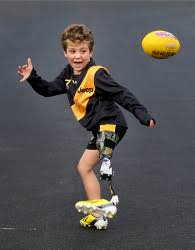Paediatric Prosthetics
 At OPS, our Paediatric Prosthetists take great care in fostering relationships with their “little clients”. The majority of our clinicians are parents themselves and understand the importance of trust and communication when working with children. They use many strategies to ensure the environment remains happy and calm.
At OPS, our Paediatric Prosthetists take great care in fostering relationships with their “little clients”. The majority of our clinicians are parents themselves and understand the importance of trust and communication when working with children. They use many strategies to ensure the environment remains happy and calm.
At OPS we believe in a team approach. By listening to parents and their children, as well as physicians and therapists, we are able to achieve the optimal outcome for each individual child. Children who experience limb loss are especially unique because of their high levels of activity and the tremendous amount of growth they experience. At OPS we understand the importance of keeping up with a young amputee’s active lifestyle. As a result we schedule regular follow-up appointments with our younger clients to monitor, adjust and replace prostheses as they develop and mature.
WHAT TO EXPECT
INITIAL APPOINTMENT
Where possible, explain to your child what is going to happen Bring any relevant medical records, x-rays or referrals Dress your child in loose clothing to make examination easier
Bring along any toys, books, security objects or small rewards that will help keep your child happy and calm (we have DVD’s to screen if required)
Prepare a list of any questions you may have for the Prosthetist.
CASTING
Dress your child in loose, older clothing as it may get splashed with plaster that is hard to remove.
Bring a DVD if your child has a favorite that they like to watch.
FITTING
Be prepared to listen to your child if they express discomfort when trying on their new limb.
Open communication is vital to ensure the correct fit and function of the prosthesis.
You will be given a schedule to introduce the prosthesis to your child as well as information on how to look after the prosthesis.
REVIEW
- Make a list of any problems your child has experienced with their prosthesis
- Use a pencil to mark any pressure areas on the socket
- Note how willing your child has been to wear the prosthesis and for how long
- Where relevant, has your child been able to put on and take off the prosthesis by themselves



